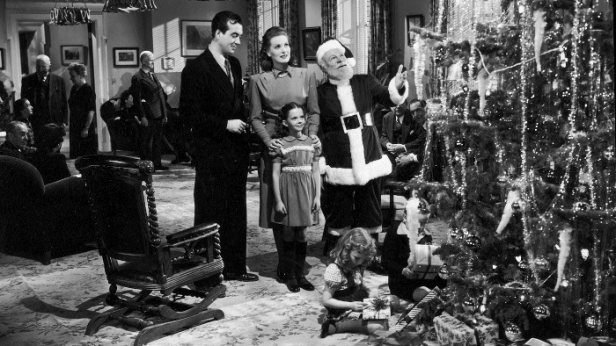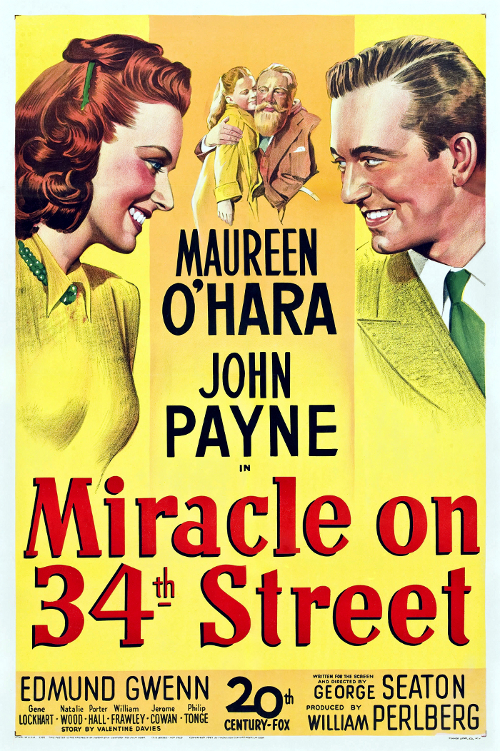On the surface, George Seaton’s Miracle on 34th Street is just a nice Yuletide story about a kindly old man who believes that he’s Santa Claus. But tucked away just below the surface of this seemingly light and fluffy seasonal favourite runs a potent streak of satire, Seaton (who wrote the screenplay from Valentine Davies’ story) taking firm aim at both the rampant commercialism of Christmas and the destructive nature of cynicism.
Kris Kringle (Edmund Gwenn) befriends Macy’s employee Doris Walker (Maureen O’Hara) when she offers him the chance to stand in for a drunken Santa Claus in the Macy’s Thanksgiving Day Parade in New York on the grounds that he looks uncannily like our image of what Santa should look like. And there’s a good reason for that. He is Santa Claus – or at least that’s what he claims. Attorney Fred Gailey (John Payne), Doris’s neighbour, and her young daughter Susan (Natalie Wood) also find themselves in Kringle’s orbit as he slowly persuades them that he really is who he says he is. But a psychiatrist, Granville Sawyer (Porter Hall), deems him to be insane and has him committed and put on trial. Kringle now has to prove that he really is Santa Claus in a cynical and materialistic world.

Gwenn is thoroughly charming as the affable Kris Kringle (when he bagged the Oscar for Best Actor in a Supporting Role, one of three Academy Awards it took home he became the first and only actor to win for playing Santa), adrift in a world that increasingly refuses to believe in him though he refuses to give up believing in anyone else and their innate goodness. Cleverly, the film’s own cynicism mostly comes from a young child, Susan, nicely played by a refreshingly unprecocious eight-year-old Natalie Wood, her natural sense of wonder suppressed by her well-meaning but hopelessly misguided mother and only released when she surrenders her disbelief and accepts Kringle for who he says he is.
Adults, and particularly adults in positions of authority, don’t come out of Miracle on 34th Street looking at all good. If there’s a villain here it’s Dr Sawyer with his relentless need to file the eccentricities off Kringle and make him conform – even if Kringle isn’t really who he says he is, what harm is he doing anyone? At worst he’s delusional, at best he’s simply spreading a little kindness in a world clearly in dire need of it. The other “bad guys” might be the venal retailers cynically subverting Kringles decency. He briefly has them working together to recommend customers to each other but they soon start turning that to their own avaricious ends.

But it’s also a film about the power of belief, both religious and secular: “Faith is believing in things when common sense tells you not to,” notes Gailey, while Kringle observes that “Christmas isn’t just a day – it’s a frame of mind.” Religion doesn’t get much of a look in, despite it being a Christmas film. It’s not about that – it’s about ordinary niceness, no matter what else you may believe in. At heart it’s a story of how simple acts of kindness and decency can make a real difference. It’s a genuine feelgood film that never resorts to cheap sentimentality or syrupy platitudes but is packed to the rafters with wonderful, often very moving, set-pieces: Kringle speaking fluent Dutch to a clearly traumatised orphan girl is a highlight, his sparring with Sawyer is hilarious and his attempts to get Susan to loosen up by impersonating a monkey are a joy.
Even the courtroom drama is gripping and at times very funny indeed (there are some great newspaper headlines covering the trial including the immortal “Kris Kringle Krazy? Kourt Kase Koming ‘Kalamity’ Kry Kiddies”) and the ending is very clever. It lifts the spirits but leaves a glimmer of doubt as to whether Kringle really was Santa after all. It seems to end on Christmas miracle but maybe it’s just another act of goodwill by an eccentric old man who refuses to allow the scepticism of the modern world to get him down. Indeed the film may not be a fantasy at all – it’s up to you really. Do you want to believe that Kringle is Santa? Then it’s a fantasy film. You don’t, then it’s a story about an odd old man, possibly mentally ill, who just does nice things. The point of the film is that Kringle himself – and later others – believes that he’s Santa and that’s all that matters.

Bizarrely, producers 20th Century Fox originally released the film in May, supported by posters and trailers featuring celebrities like Rex Harrison, Anne Baxter and Peggy Ann Garner that made absolutely no mention of Christmas at all. Studio head Darryl F. Zanuck felt that more people went to the cinema in the warm weather so despite the film being set in the period between Thanksgiving and Christmas, opted for a summer release. But by the time the film had done the rounds of the big cities and made its way into rural and provincial bookings, Christmas was almost upon it and word of mouth from the earlier releases resulted in a big box office hit that was on its way to becoming a perennial seasonal favourite.
Over the years it’s proved so popular that it’s been remade several times: as an episode of the television series The 20th Century-Fox Hour in 1955, as television films in 1959 and 1973 and as a big budget theatrical reworking starring Richard Attenborough as Kringle in 1994. There were also radio and theatrical adaptations. But the original remains the best. And whatever time of year you see it, Miracle on 34th Street is a marvellous film, inspiring without being corny, heartwarming without being sentimental and shot through with a streak of satire and a plea for everyone to just stop being so bloody horrible to each other all the time. No wonder it’s stood the test of time. Park your cynicism, give into Kringle’s belief in the power of the imagination and hope that you could be even half as decent as Kris Kringle. As ever, the hideous colourised version is to be avoided at all costs.